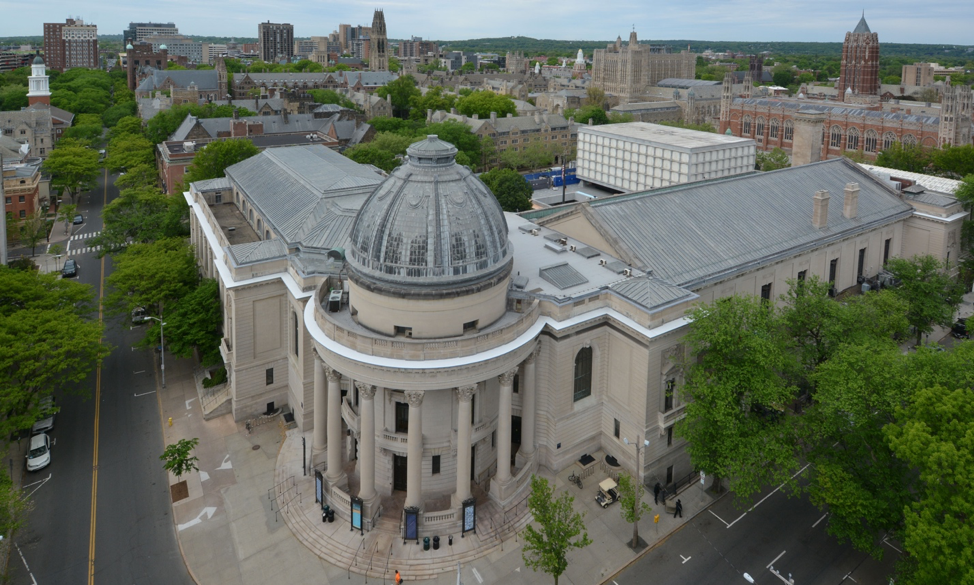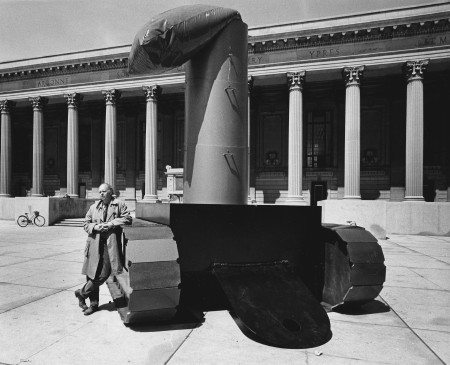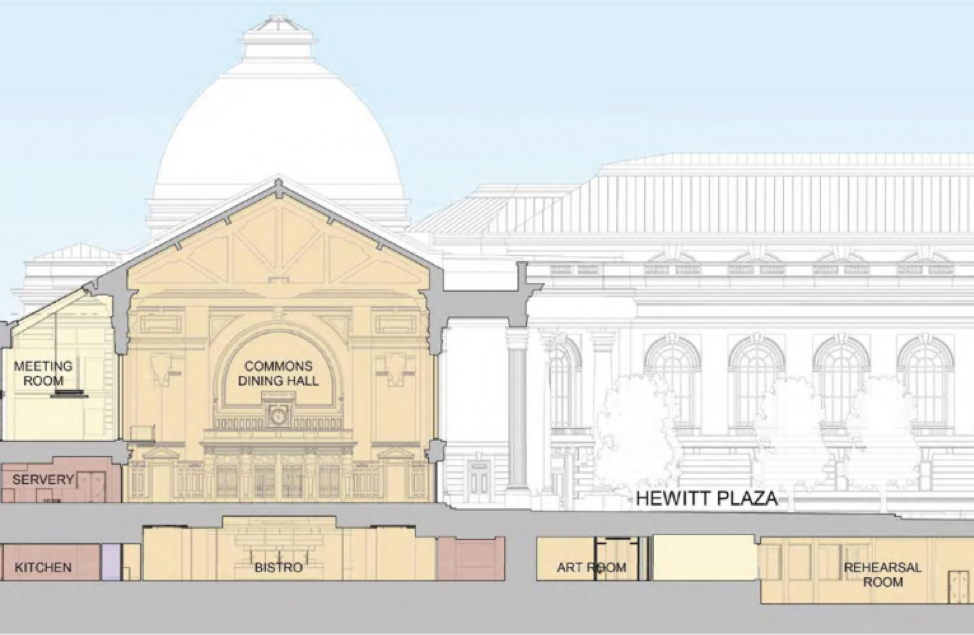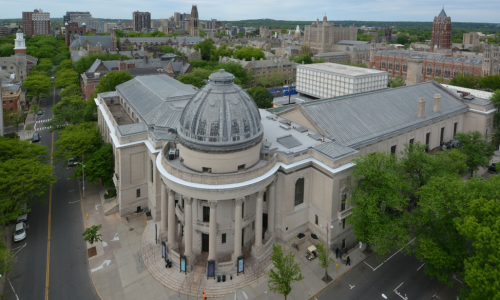So What’s All This We Hear About the Schwarzman Center?

In the course of our 50th Reunion activities, we were reminded in casual but animated conversation during our Class Dinner, that University Commons is being completely renovated into a campus-wide student center, including its traditional role as the principal dining hall for the university.
First, some history. University Commons (1902) is part of the Yale Bicentennial buildings that include Commons Dining Hall, where we were required to take most of our meals as lonely freshmen living on the Old Campus; Woolsey Hall (1901), the University’s largest performance space, where Kingman Brewster addressed the ‘future leaders’ in September of our freshman year; and Memorial Hall (the Rotunda) (1902), where Yale’s war veterans are honored, a reminder ‘that their devotion may pass to others as a living fire.’
The limestone Beaux-Arts buildings are part of Yale’s Hewitt Quadrangle, along with the Beinecke Library (1963) and Woodbridge Hall (1901). There, in what we used to call the ‘ersatz platz,’ who could forget Claes Oldenburg’s ironic monumental sculpture, Lipstick (Ascending) on Caterpillar Tracks, now departed?

And who is that leaning in to it, but the sculptor himself?
The original Commons was created when institutional food service began at Yale in 1718 with the opening of the first College building in New Haven. It didn’t take long for students to complain about the quality of the food. In 1721, the young Jonathan Edwards reported to his father that the students had gone on strike over the fare. Improvements were made, and there things remained through the rest of the century. In 1828, students staged the great “Bread and Butter Rebellion,” refusing to enter Commons or to attend classes until the faculty met their demands for better food. In 1842, the original Commons surrendered and was replaced by private eating clubs (like Princeton to this day). In 1866, Yale opened an eating club for those who could not afford the private ones, a new Commons. And 1901 brought the Commons that we knew on Grove Street, providing large-scale centralized dining to the whole community.
Fraternity houses had started to serve meals in the 1920’s, but once the residential colleges were completed in the early thirties, the frat houses were crowded out: they could not compete with the colleges’ majestic dining halls that provided an elegant ambience, including waitresses who served each course separately on custom china. Alas, the waitresses were gone by the time we got there.
And so into the 21st century, enter the Schwarzman Center at University Commons. Yale will at last have a building dedicated to student life. The renovation includes the main floor and basement of Commons and the basement and upper two floors of Memorial Hall, a total of 87,000 square feet. Historic Commons will continue to serve major university events like reunions and student lunch service, and will be renovated to host a variety of other kinds of events (performing art and cultural activities, exhibits, large dances, educational panels and discussions connected to the outside world). Small rooms inside the complex could be used by any number of student organizations through an online sign-up system. Mid-sized rooms will be used for improv, chamber concerts, yoga classes, gallery space, meeting rooms for career counseling with alumni. The list is endless. Just about any student activity will be accommodated: meetings, parties, conversations. A place for the students and by the students, undergraduates and graduates alike.
The renovation and construction of the Center involve several interconnected parts. Commons was not just a hub for dining on campus, but also a hub for mechanical and electrical infrastructure that feeds large portions of the campus. The focus at the start of construction was the relocation and rebuilding of a new infrastructure. As one would expect, such a project has an archaeological side. In the sub-terrain addition to Hewitt Plaza, several concrete impediments were found that had to be removed, including the original flagpole installed in the 1950s when Beinecke Plaza was built. Unique architectural elements were uncovered that were built in the 1900s: large brick arches; plaster filigree highlights buried behind walls built over time; large granite block foundations; a coal rail system located in the basement and used to transport coal for heat.

The project is viewed here from the Book and Snake/Law School side. The Rotunda on the corner of College and Grove is outlined behind Commons and Woolsey Hall is outlined on the right. The Grove Street addition on the left pushes the building out to the edge of the sidewalk on Grove Street, across from the Cemetery. It will have skylights bringing light into the main level of Commons; an open loft level along its length for offices; and a serving area adjacent to the main level.
The most impressive part of the project is the basement level, formerly a rabbit-warren of rooms for food prep, cooking and storage, as well as the mechanical and electrical systems. The height (11 feet) was too low, so the floor was dug out, a delicate operation requiring that the foundation be continuously supported in the process. The result is larger space for kitchen work below the Grove Street addition and below the main level. The basement also includes a student bistro.
The main-level dining hall itself will remain intact but restored and cleaned up, from the terrazzo floor to the age-darkened beam structure holding the roof.
The Rotunda (seen in the background) is another element of the project. Its circular basement will be restored for use; the ground-level Memorial Hall will be preserved and enhanced; the second floor President’s room will continue to have some University functions, like the Yale Corporation meetings; the Hall adjacent to it will be used for exhibition space; and finally, the third floor (open to the Oculus and the sky) will house an additional functional space for, say, chamber concerts, with an adjacent hall that can be used for exhibition space. And there is still more usable space, for offices or meeting rooms.
Finally, the open space in the middle of the Hewitt Quadrangle, Beinecke Plaza, will be dug out. Rooms will be created for art work, rehearsals, etc., then covered up again, much like the Sterling Library extension under the Cross Campus. Wait. There is more. The colonnaded area between Commons and the Plaza will be used as an outdoor café.
This is a breathtaking and magnificent undertaking. It provides active space, available to the entire student body, a center dedicated to cultural programming and student life at the heart of the University. And I can’t wait to see it. Oh, and the food is now so much better.
(I’ve borrowed heavily from Judith Ann Schiff, head of the Archives at Sterling. She knows everything there is to know about Yale and New Haven, including their secret histories. And also from Michael Douyard, Project Manager, of the Yale Office of Facilities, Planning and Construction.)


So, what I want to know is the new(?) name of Commons? Is the old dining area retaining the name of Commons, or is it to be the Schwarzman Center?
If I’m forming an accurate picture of what this place will be like, it will function in a similar way to what on many other campuses is known as the Student Union. I guess I had always assumed that Yale didn’t have such a place because having one would somewhat violate the philosophy behind the college system. Has any thought been given to what effect this central facility will have on programs and activities that now take place within the colleges?
JP
Thanks for the story. Very illuminating. (FYI, my recollection is that Yale had the best food of any of the Ivies when we were there. Hope this renovation allows that tradition to continue.)